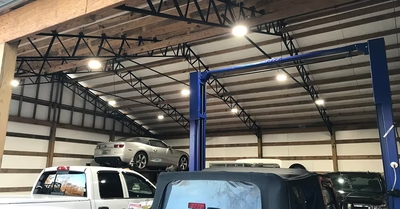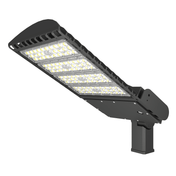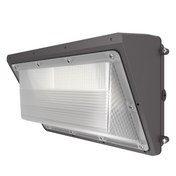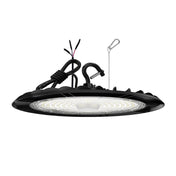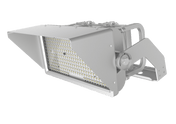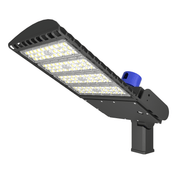Introduction
In industrial and commercial spaces, lighting is like the "eyes" of the space; its importance is undeniable. Appropriate lighting not only enhances the visual appeal of a space but is also closely linked to productivity, employee comfort, product display, and energy costs. From busy factory floors to bustling shopping malls, from towering warehouses to expansive stadiums, adequate and high-quality lighting is essential for the smooth running of all activities.
Fluorescent lamps have long been a staple in industrial and commercial lighting. With their relatively low cost and wide range of applications, they have illuminated countless spaces for decades. However, with the rapid advancement of technology, a more advanced and efficient lighting fixture—LED high-bay lamps—is gradually emerging as the preferred choice for lighting upgrades for many businesses and venues. Upgrading from fluorescent lamps to LED high-bay lamps is more than a simple fixture replacement; it represents a comprehensive overhaul of the lighting system and a wise move towards a new era of efficient, energy-saving, and environmentally friendly lighting. Let's delve deeper into the many advantages and far-reaching implications of this upgrade.
1. Introduction to Fluorescent Lamps and LED High Bay Lights
(I) Working Principle and Characteristics of Fluorescent Lamps
Fluorescent lamps, also known as fluorescent lamps operate based on the discharge of low-pressure mercury vapor. When current passes through a fluorescent lamp, it first excites the mercury vapor inside the tube, causing it to emit ultraviolet light. These ultraviolet rays are invisible, but the phosphor coating on the inner wall of the tube absorbs them and converts them into visible light, thus providing illumination. During this process, fluorescent lamps typically require a ballast to stabilize the current flow and aid in starting. During startup, the ballast generates a transient high voltage to facilitate the discharge of the gas within the tube. During normal operation, it stabilizes the current flow and prevents excessive current.
In the past, fluorescent lamps were widely used in industrial and commercial lighting due to their relatively low cost and higher luminous efficiency than incandescent lamps. They offer a softer light and meet the requirements of common scenes, reproducing the colors of objects more faithfully. However, with the passage of time and technological advancements, the shortcomings of fluorescent lamps have become increasingly apparent. Fluorescent lamps have high energy consumption and relatively low efficiency in converting electrical energy into light. A significant amount of energy is wasted generating heat and maintaining the lamps. Furthermore, fluorescent lamps have a relatively short lifespan, typically around 8,000 to 15,000 hours. Frequent lamp replacement not only increases maintenance costs but also disrupts the normal operation of the venue. Furthermore, fluorescent lamps contain hazardous substances such as mercury. If the lamp breaks or is improperly disposed of, mercury leakage can pose serious risks to the environment and human health. Furthermore, fluorescent lamps require a preheating period before starting, preventing them from reaching full brightness instantly. In cold environments, they may experience difficulty starting or reduced brightness. Some fluorescent lamps also have difficulty dimming and flicker, which can negatively impact vision.
(II) Operating Principle and Features of LED High Bay Lights
The operating principle of LED high bay lights is based on the properties of semiconductors. They convert electrical energy directly into light energy via a semiconductor chip. When current flows through the LED chip, electrons and holes within the chip recombine, releasing photons and generating light. Unlike the complex energy conversion process of fluorescent lamps, LED high-bay lights have extremely high photoelectric conversion efficiency, converting most electrical energy directly into visible light, significantly reducing energy loss.
LED high-bay lights typically contain key components such as the power supply circuit, LED light source, and heat dissipation system. The power supply circuit is responsible for converting the input AC power into DC power suitable for the LED chip. The LED light source is the core component of the light source and uses high-quality LED chips with high luminous efficiency and strong stability. The heat dissipation system is crucial because LEDs generate a certain amount of heat during operation. If heat is not dissipated promptly, the chip temperature will rise, affecting the luminous efficiency and lifespan. High-quality LED high-bay lights typically use efficient heat dissipation materials and designs, such as aluminum alloy heat sinks and heat pipes, to ensure that the lamps maintain a low temperature and stable operation during operation.
LED high-bay lights have many significant advantages. In terms of energy saving, they are significantly more energy-efficient than fluorescent lamps, significantly reducing energy consumption and saving businesses significant electricity costs. Their extremely long lifespan, typically reaching 50,000 hours or even longer, means frequent lamp replacements are unnecessary for extended periods, significantly reducing maintenance costs and the inconvenience associated with replacements. From an environmental perspective, LED high-bay lights contain no harmful substances like mercury, leaving them environmentally friendly and meeting modern society's commitment to green solutions. In terms of color rendering, LED high-bay lights offer a high color rendering index (Ra > 80 or even higher), accurately reproducing the true colors of objects. This is particularly important in locations with demanding color requirements, such as merchandise display areas in shopping malls and precision manufacturing workshops. Furthermore, LED high-bay lights offer instant-on operation, requiring no preheating and reaching full brightness immediately upon power-up. They also exhibit zero flickering, preventing eye fatigue and damage, and providing users with a more comfortable and healthy lighting environment.
2. Economic Benefits of Upgrading to LED High-Bay Lights
(I) Significant Energy Savings, Lower Electricity Bills
In the lighting sector, energy consumption has always been a significant component of business operating costs. LED high-bay lights offer exceptional energy savings, offering significant advantages over fluorescent lamps. Regarding energy consumption, the luminous efficacy of traditional fluorescent lamps typically ranges from 55 to 80 lumens per watt (lm/W), while LED high-bay lights can reach 100 to 150 lm/W or even higher. This means that to provide the same brightness, LED high-bay lights require less power and, consequently, consume less energy.
For example, consider a large warehouse covering 5,000 square meters. Suppose the warehouse originally used 500 40W fluorescent high-bay lights, operating for 10 hours per day. Based on the local electricity rate of 1 yuan per kilowatt-hour (kWh), the warehouse's annual electricity bill for fluorescent lighting alone is as high as: 40W × 500 lights × 10 hours/day × 365 days ÷ 1000 (converting watts to kilowatts) × 1 yuan/kWh = 73,000 yuan.
If all these fluorescent high-bay lights were replaced with 20W LED high-bay lights, providing the same sufficient brightness, with the same lighting hours and electricity price, the annual electricity bill would become: 20W × 500 lights × 10 hours/day × 365 days ÷ 1000 × 1 yuan/kWh = 36,500 yuan. This comparison clearly shows that by replacing these LED high-bay lights, the warehouse can save 36,500 yuan in electricity costs annually, a significant energy saving effect. Moreover, these electricity cost savings become even more significant over time, saving businesses significant money in the long term.
(II) Long Lifespan, Reduced Replacement and Maintenance Costs
Another significant advantage of LED high-bay lights is their exceptionally long service life. Generally speaking, fluorescent lamps have a lifespan of approximately 8,000 to 15,000 hours, while LED high-bay lights typically last over 50,000 hours, with some high-quality products even reaching 100,000 hours. This significant difference gives LED high-bay lights a clear advantage in terms of replacement and maintenance costs over long-term use.
Frequently replacing fluorescent lamps not only requires purchasing new fixtures, but also incurs labor costs. For example, for a medium-sized factory, assuming the labor cost of replacing a fluorescent lamp is 50 yuan (including climbing, removing the old lamp, and installing the new one), and the lamp procurement cost is 30 yuan, the total cost of replacing a fluorescent lamp is 80 yuan. If a factory has 1,000 fluorescent lamps, with an average lifespan of 10,000 hours and an annual operating time of 2,000 hours, then 200 lamps would need to be replaced annually, with the replacement cost alone reaching 200 x 80 = 16,000 yuan.
However, using LED high-bay lamps, due to their long lifespan, may not require lamp replacement for 5-10 years, significantly reducing this expense. Furthermore, lighting failures can cause production interruptions, resulting in additional losses for the company. In a manufacturing company, every interruption can mean delayed product delivery, equipment idling, and reduced worker efficiency. For example, if a fluorescent lamp failure causes a production line to stop for even one hour at an electronics manufacturer, thousands of products could be delayed. Assuming a net profit of 5 yuan per product, this one-hour loss could amount to tens of thousands of yuan. LED high bay lights, with their stability and long life, can effectively reduce the probability of lighting failures, avoid production interruptions caused by lighting problems, provide reliable protection for the normal operation of the enterprise, and further reduce potential economic losses.
3.Environmental Benefits of Upgrading to LED High Bay Lights
(I) Mercury-Free, Environmentally Friendly, and Reduced Pollution Risks
With growing environmental awareness, the environmental performance of lighting products is gaining significant attention. While fluorescent lamps once held a prominent position in the lighting industry, their mercury content has become a serious environmental hazard. Fluorescent lamps are filled with mercury vapor, a highly toxic, persistent, and bioaccumulative heavy metal. Once a fluorescent lamp is broken or improperly disposed of, mercury is released into the environment. Mercury evaporates at room temperature, and its vapor quickly diffuses into the air. Once inhaled, it can damage the central nervous system, digestive system, and kidneys. Even low-level exposure can damage the nervous system and cause sensory abnormalities, intellectual disability, and speech disorders. Furthermore, mercury can enter the food chain through air, water, and soil, harming the entire ecosystem.
In contrast, LED high bay lights offer significant environmental advantages. They contain no mercury or other harmful substances. This means there is no risk of mercury contamination during the production, use, and disposal of LED high bay lights. When LED high-bay lights reach the end of their lifespan, their waste can be recycled and reused, and most components can be effectively recycled, further reducing environmental impact. For example, metal components in LED high-bay lights, such as aluminum heat sinks, can be recycled and remelted for use in new products. Their electronic components can also be processed professionally to extract valuable metals, achieving resource recycling. This environmentally friendly feature not only meets current demands for green products but also demonstrates a company's social responsibility for environmental protection.
(II) Reducing Energy Consumption and Supporting Sustainable Development
The high efficiency and energy-saving nature of LED high-bay lights has far-reaching implications for environmental protection and sustainable development. Energy production and consumption are closely linked to environmental issues. Traditional power generation methods, such as coal-fired power generation, release large amounts of greenhouse gases such as carbon dioxide and sulfur dioxide while generating electricity. These gases are significant contributors to environmental problems such as global warming and acid rain.
Due to their low energy consumption, LED high-bay lights significantly reduce energy consumption compared to fluorescent lamps while providing the same lighting effect, indirectly reducing carbon emissions generated during the power generation process. For example, if a factory with an annual electricity consumption of 1 million kWh were to replace all of its existing fluorescent high-bay lights with LED high-bay lights, assuming LED high-bay lights use 40% less energy than fluorescent lights, it could save 400,000 kWh of electricity annually. According to relevant data, each kWh of electricity generated produces an average of approximately 0.8 kg of carbon dioxide emissions. Therefore, this factory could reduce carbon dioxide emissions by approximately 320,000 kilograms (320 tons) annually, contributing positively to mitigating global climate change.
In addition, reducing energy consumption also means reducing dependence on finite energy resources. As global energy demand continues to grow, non-renewable energy sources such as oil and coal are becoming increasingly scarce. The development and utilization of these energy sources also cause environmental damage, such as land subsidence and vegetation destruction caused by coal mining. Using LED high-bay lights can reduce demand for these non-renewable energy sources, promote sustainable energy utilization, and drive society towards green and sustainable development. This aligns with the company's long-term strategic development goals and creates a better living environment for future generations.
4. Performance Advantages of Upgrading to LED High Bay Lights
(I) High Brightness and Uniform Illumination
Sufficient and uniform lighting is crucial in industrial and commercial spaces. LED high bay lights, with their superior performance, offer significant advantages in this regard. Luminous flux data shows that LED high bay lights generally offer high luminous flux. For example, a common 100W LED high bay light can achieve 12,000-15,000 lumens (lm), or even higher, providing exceptionally bright illumination for large spaces.
LED high bay lights excel in uniform light distribution. Through carefully designed optical systems, such as specialized lenses or reflectors, light can be precisely controlled and distributed. For example, in a large factory workshop, installing LED high bay lights ensures uniform light distribution throughout the entire room, with minimal variations in brightness. In some precision manufacturing workshops, workers require high brightness and a shadow-free environment. LED high-bay lights can evenly distribute light across the work area, effectively reducing shadows caused by uneven lighting and avoiding product quality issues caused by visual errors, significantly improving work efficiency and product quality. Furthermore, the uniform light distribution reduces glare, making it more comfortable for employees' eyes while working and reducing visual fatigue, further safeguarding their work status and physical health.
(II) Instant Start and Flicker-Free
In lighting applications, the start-up speed and flicker-free behavior of a lamp significantly impact the user experience. LED high-bay lights offer instant start-up, making them highly suitable for illuminating various locations. The instant start-up feature of LED high-bay lights allows them to quickly achieve full brightness upon power-up, eliminating the need for a warm-up period of several seconds or even longer, as with fluorescent lamps. The instant start-up feature of LED high-bay lights is particularly important in locations where fast light response is crucial, such as emergency lighting areas and warehouse entrances where lights are frequently turned on and off. In the event of an emergency, emergency LED high-bay lights can illuminate instantly, providing timely illumination support for evacuation and rescue efforts, ensuring personal safety.
The flicker-free nature of LED high-bay lights is also a major draw. Flicker refers to the rapid flickering of light over a period of time. Traditional fluorescent lamps are prone to flickering due to their operating principles. Prolonged exposure to flickering light can cause eye fatigue, dryness, headaches, and other discomfort, and can even damage vision. LED high-bay lights, however, utilize advanced constant current drive technology to deliver a stable current output, ensuring continuous and steady light, fundamentally eliminating flicker. In places where people spend extended periods of time, such as shopping malls, schools, and offices, LED high-bay lights provide a comfortable and healthy lighting environment, allowing people to relax their eyes while working, studying, and shopping, improving work and learning efficiency and enhancing the consumer shopping experience.
(III) Rich Color Temperature and High Color Rendering
Different lighting scenarios require different color temperatures and color rendering. LED high-bay lights excel in this area, offering users more choices and superior lighting effects. LED high-bay lights offer a wide range of color temperatures, generally ranging from 2700K to 6500K. LED high-bay lights with lower color temperatures (2700K to 3500K) emit a warm yellow hue, creating a cozy and comfortable atmosphere. They are ideal for use in shopping mall lounges, hotel lobbies, and other locations, allowing people to relax and unwind. Meanwhile, LED high-bay lights with higher color temperatures (5000K to 6500K) emit light that resembles natural daylight, creating a fresh and bright impression. They are suitable for locations such as factory workshops and warehouses where clear vision and focused work are essential, enhancing employee concentration and productivity.
LED high-bay lights also boast high color rendering, which significantly enhances their appeal. Color rendering refers to a light source's ability to reproduce the color of an object. It is typically measured by the color rendering index (Ra). A higher value indicates better color rendering and a more realistic color reproduction. The color rendering index of LED high-bay lights generally reaches over 80, with high-quality products reaching over 90. In shopping malls, high-color-rendering LED high-bay lights can truly present the colors and details of products, giving consumers a clearer understanding of the products and increasing their purchasing desire. In art exhibition halls, high-color-rendering lighting is crucial for showcasing the colors and textures of artworks, allowing viewers to better appreciate and experience the charm of the works.
5. Case Study
Many companies have achieved significant results after upgrading their lighting systems. For example, a large automobile manufacturing plant originally used traditional fluorescent high-bay lighting in its workshops. As production scale expanded and production environment requirements increased, the drawbacks of these fluorescent lamps became increasingly apparent. Not only was the insufficient brightness a factor, leading to errors during delicate tasks, but frequent lamp replacements and high electricity costs also placed a significant financial burden on the company.
After conducting detailed market research and cost-benefit analysis, the plant decided to replace all 1,000 fluorescent high-bay lights in its workshops with LED high-bay lights. These LED high-bay lights have a power of 150W, a luminous flux of 20,000 lumens, and a color rendering index of 85. The upgrade significantly improved the lighting quality. The average illumination in the workshop increased from 200 lux to 500 lux, significantly improving light uniformity and virtually eliminating shadows. This significantly enhanced workers' visual comfort and work efficiency. According to factory statistics, within six months of the lighting upgrade, the defective product rate due to lighting issues decreased by 30%, and production efficiency increased by 15%.
In terms of economic benefits, before the renovation, the workshop's annual electricity bill was approximately 800,000 yuan (due to the high-wattage and numerous fluorescent lamps). After switching to LED high-bay lights, this cost was reduced to 300,000 yuan, resulting in an annual electricity savings of 500,000 yuan. Furthermore, due to the long lifespan of LED high-bay lights, replacement is virtually unnecessary within five years, saving approximately 100,000 yuan in annual lamp replacement and maintenance costs. Overall, this translates to an annual cost savings of 600,000 yuan for the company, effectively paying for the investment in the lighting system upgrade within just two to three years.
For example, a large warehouse-style supermarket previously used fluorescent lamps, which had numerous shortcomings in terms of lighting quality and energy efficiency. The uneven lighting across the shelves resulted in poor product display, impacting the customer experience. After switching to LED high-bay lights, the supermarket's lighting environment has been completely transformed. The high color rendering of LED high-bay lights makes merchandise appear more vibrant and eye-catching, enabling customers to more clearly select items, which has significantly boosted sales. According to supermarket feedback, sales increased by 8% in the first month after the lighting upgrade, and this growth trend has continued in subsequent months. Regarding energy costs, the supermarket's monthly electricity bill has been reduced by 40%, saving approximately 300,000 yuan annually, while maintenance costs have also been significantly reduced. These real-world cases fully demonstrate the significant advantages of upgrading from fluorescent lamps to LED high-bay lights in terms of improved lighting quality, reduced costs, and increased economic benefits.
6. Upgrade Considerations and Recommendations
(I) Budget Planning
Budget planning is a crucial step in upgrading from fluorescent lamps to LED high-bay lamps. While LED high-bay lamps offer significant energy and cost savings over the long term, initial purchase costs are higher than those of fluorescent lamps. This is because LED high-bay lamps utilize more advanced technology and high-quality materials, such as efficient LED chips, superior heat dissipation components, and intelligent driver circuits, all of which contribute to increased production costs. For example, a typical 40W fluorescent high-bay lamp may cost around 50-100 RMB, while a 15W-20W LED high-bay lamp with comparable lighting performance may cost between 200-500 RMB, depending on brand, quality, and features.
However, focusing solely on initial purchase costs is short-sighted. From a lifecycle perspective, LED high-bay lamps offer a higher cost-performance ratio. As mentioned above, LED high-bay lights offer significant energy savings, significantly reducing electricity bills. Their long lifespan also reduces the maintenance costs associated with frequent lamp replacements. Therefore, when planning budgets, companies should consider long-term benefits. They can create a detailed cost analysis that factors in electricity costs, maintenance costs, and lamp replacement costs over the next 5-10 years. Furthermore, companies can monitor market trends and purchase LED high-bay lights during promotional events, or negotiate with suppliers for more favorable prices and payment terms to reduce initial financial pressure.
(II) Lighting Selection
Choosing the right LED high-bay light is crucial for ensuring the effectiveness of your lighting upgrade. The first consideration is the space, including height and area. Generally speaking, for spaces 5-8 meters in height, 100W-150W LED high-bay lights are suitable; taller spaces (over 8 meters) require 150W-300W or even higher-wattage fixtures. The number of lamps should also be reasonably calculated based on the space area and lighting requirements to ensure adequate and even illumination throughout the space. For example, in a 1,000-square-meter warehouse, using 150W LED high-bay lights, 30-40 fixtures may be required, based on lighting design specifications and experience. The specific number also needs to consider factors such as the luminous flux, beam angle, and the layout of the items within the warehouse.
Lighting requirements are also a key factor in selecting lamps. Different locations have different lighting requirements. For example, a factory floor may require high-brightness and high-color rendering lighting to ensure workers can perform production operations accurately. Shopping malls, on the other hand, prioritize the display of merchandise and require lighting with high color rendering and an appropriate color temperature. Regarding color rendering, LED high-bay lights with a color rendering index (Ra) greater than 80 should be selected. For locations with strict color requirements, such as jewelry stores and art galleries, products with an Ra greater than 90 are recommended. The choice of color temperature should be determined by the venue's ambiance and function. As mentioned above, warm color temperatures (2700K - 3500K) are suitable for creating a warm and comfortable atmosphere, while cool color temperatures (5000K - 6500K) provide clear, bright light.
Brand and quality are also crucial. Well-known brands typically have stricter production standards and quality control systems, ensuring their products are more reliable in terms of performance, stability, and after-sales service. Mainstream brands in the market, such as OPPLE Lighting, NVC Lighting, and Philips Lighting, have extensive experience and a strong reputation in LED high-bay lighting. When choosing, consider user reviews and product certifications, such as 3C and CE certifications, which are important indicators of compliance with relevant quality and safety standards. Furthermore, the heat dissipation performance of the lamp is crucial. Good heat dissipation ensures stable operation of the LED chips and extends the lamp's lifespan. High-quality LED high-bay lights typically use heat sinks made of materials with good thermal conductivity, such as aluminum alloy. Heat dissipation efficiency is enhanced through rational heat dissipation structural design, such as increasing the area and number of fins and employing heat pipe technology.
Dimming and intelligent control are also key features of modern LED high-bay lights. Dimming allows for flexible adjustment of light brightness based on time of day and scene requirements, further saving energy. For example, during the day when natural light is abundant, the light brightness can be lowered, while at night or on cloudy days when light levels are low, the brightness can be increased. Intelligent control makes lighting systems more convenient and efficient. By connecting to intelligent control systems such as the Internet of Things (IoT), Bluetooth, and Wi-Fi, remote control, timer switching, and light sensor adjustment are enabled. For example, in large warehouses, LED high-bay lights can be remotely controlled using a mobile app to turn them on and off, or timers can be set to automatically shut off the lights during unoccupied hours, avoiding energy waste.
(III) Installation and Retrofitting
When installing LED high-bay lights, there are many details to consider. Mounting height directly impacts lighting quality and light distribution. Generally speaking, the mounting height of a luminaire should be determined based on the room height and the luminaire's beam angle. For typical LED high-bay lights, if the room height is 10 meters, the luminaire should be mounted at a height of approximately 8-9 meters to ensure even light coverage of the work area below and avoid blind spots or areas of excessively bright or dim light. Mounting angle is also crucial; ensure that the luminaire's light strikes the work surface perpendicularly or nearly perpendicularly to improve lighting efficiency and uniformity. For example, in a factory production line area, the luminaire's mounting angle can be fine-tuned based on the production line layout to better illuminate production equipment and operating areas.
The spacing between luminaires is equally important; a reasonable spacing ensures uniform lighting throughout the space. Typically, spacing can be calculated based on the luminous flux and beam angle of the luminaire. Generally, for a given luminous flux, the larger the beam angle, the greater the spacing. Taking a 150W LED high-bay light with a 120° beam angle as an example, in an 8-meter-high warehouse, the installation spacing can be controlled to approximately 6-8 meters. During the installation process, specialized tools and equipment, such as a lifting platform, screwdrivers, and wrenches, are required to ensure accurate and safe installation. When working at height, installers must wear protective equipment such as safety belts and strictly adhere to safety procedures.
Renovating the existing lighting system is also a key step in the upgrade process. When removing old fluorescent lamps, exercise caution to avoid damaging the ceiling or other fixtures. Discarded fluorescent lamps must also be properly disposed of. Because they contain hazardous substances such as mercury, they should be sorted and recycled in accordance with environmental standards and handed over to a professional disposal agency for harmless treatment. Existing lighting wiring needs to be inspected and evaluated. If the wiring is aging or lacks load capacity, it may need to be replaced or upgraded to ensure safe and stable power supply for the new LED high-bay lights. When installing new lamps, ensure the electrical connections are correct and reliable to avoid safety hazards such as short circuits and leakage. Have a professional electrician perform installation and commissioning to ensure the proper operation of the lighting system. After installation, test and adjust the lighting effect, fine-tuning the brightness, angle, and spacing of the lamps based on actual conditions to achieve optimal lighting results.
7.Conclusion
Upgrading from fluorescent lamps to LED high-bay lights is undoubtedly a major transformation in the industrial and commercial lighting sector, a wise move towards a new era of efficient, energy-saving, and environmentally friendly lighting. In terms of economic benefits, LED high-bay lights, with their significant energy-saving properties and exceptionally long lifespan, significantly reduce businesses' electricity and maintenance costs, saving them substantial capital over the long term and enhancing their competitiveness.
In terms of environmental benefits, LED high-bay lights contain no hazardous substances like mercury, reducing pollution risks. Furthermore, their reduced energy consumption contributes to sustainable development, reduces carbon emissions, and makes a positive contribution to environmental protection. In terms of performance, LED high-bay lights offer high brightness and uniform illumination, instant start-up and zero flicker, as well as a wide range of color temperatures and excellent color rendering. These lights provide users with a more comfortable, healthy, and high-quality lighting environment, meeting the lighting needs of various locations and scenarios, and improving work efficiency and quality of life.
Real-world cases have fully demonstrated the feasibility and significant effectiveness of this upgrade. Numerous companies have achieved not only improved lighting quality but also significant cost control and economic benefits after upgrading their lighting systems. While the upgrade process requires considerations such as budget planning, fixture selection, installation, and retrofitting, with adequate preparation and proper planning, a lighting system upgrade can be successfully implemented. Therefore, whether considering short-term cost savings or long-term environmental and social benefits, actively adopting LED high-bay lighting for lighting upgrades is a highly recommended option, promising a brighter, more efficient, and more sustainable future for industrial and commercial spaces.

